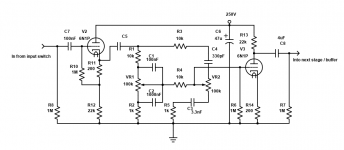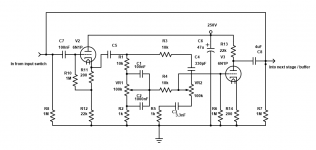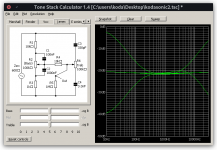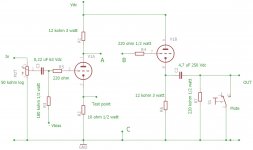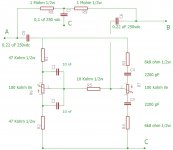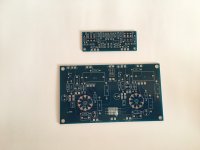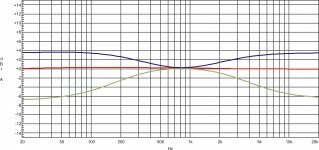Sorry for asking, but I have no formal math on this kind of circuit and it escapes me.
What's the input impedance of this tone network with the short vs without it?
Meter says 5k while shorted...
Beyond that, I could learn but I'd need "handholding" in this case.
Thanks as always 🙂
BTW I think I like the curves better with replacing all the 3's with 2's in the cap value.
Koda
What's the input impedance of this tone network with the short vs without it?
Meter says 5k while shorted...
Beyond that, I could learn but I'd need "handholding" in this case.
Thanks as always 🙂
BTW I think I like the curves better with replacing all the 3's with 2's in the cap value.
Koda
Attachments
Last edited:
You can ignore the contribution from the follower (it's very, very high-Z) so your loading is the two 1M resistors in parallel with the output impedance of the second stage. This will be the 22K anode load in parallel with the source impedance from the anode, maybe something in the 5 decimal point range. How accurate do you need to calculate it?
But otherwise, do you really want to do this? It's not ideal.
All good fortune,
Chris
But otherwise, do you really want to do this? It's not ideal.
All good fortune,
Chris
Since the signal is still going through the tone control even when shorted (and the signal gets inverted) the input impedance will be extremely low and will vary wildly with control setting. You need to kill the signal through the tone control to get a sensible result.
Thanks for the info.
I guess I'll make it switch out the signal on the bypass setting.
Without the short, it's much louder with tone than without - not a problem if you invert and short them though. It seems I'm going to need to attenuate the input of the tone control.
The sources are about 600R so a 5k load isn't the end of the world.
I guess I'll make it switch out the signal on the bypass setting.
Without the short, it's much louder with tone than without - not a problem if you invert and short them though. It seems I'm going to need to attenuate the input of the tone control.
The sources are about 600R so a 5k load isn't the end of the world.
In attach the circuit of a line stage and a optionl tone control can be added to it.
You cannuse the Ecc88 or the 6N6
Also the photo of pcb.
In addition the freq answer of tone with ECC88 and 6N6.
With ECC88 the total gain with tone inserted is around 21 dB, with 6N6 is 15 dB
I tested the circuit also with ECC99 and 12BH7A
The Zout of the first stage is reasonbale low in both tubes; the gain lost is around 6 dB for each tube.
With few jumper is possible to insert or remove the little tone pcb.
The linearity with the knob in the center is very good; the limitation on boost and attenaution is my idea of what the tone control must do
Walter
You cannuse the Ecc88 or the 6N6
Also the photo of pcb.
In addition the freq answer of tone with ECC88 and 6N6.
With ECC88 the total gain with tone inserted is around 21 dB, with 6N6 is 15 dB
I tested the circuit also with ECC99 and 12BH7A
The Zout of the first stage is reasonbale low in both tubes; the gain lost is around 6 dB for each tube.
With few jumper is possible to insert or remove the little tone pcb.
The linearity with the knob in the center is very good; the limitation on boost and attenaution is my idea of what the tone control must do
Walter
